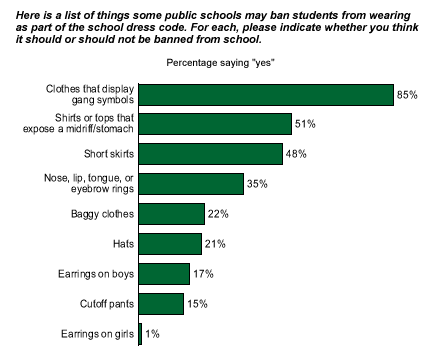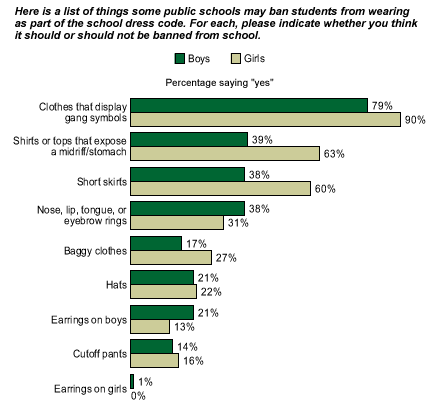Teenagers do not like to be told what to do. As they struggle to discover their own unique identities, teens often rebel against any perceived attempts to "cramp their style." So, it may come as little surprise that a new Gallup Youth Survey* finds that about half (51%) of 13- to 17-year-old respondents don't feel public school officials should be able to restrict what students wear.
Gender seems to play a role in teens' opinions about dress codes. While a slight majority of girls (57%) support restrictions on school wear, fewer boys (42%) agree.
Students who describe themselves as high-achieving academically are also considerably more receptive than other teens to clothing restrictions -- 59% of those who said they are "near the top of their class" academically think school officials should be able to restrict what students wear, compared to 47% of those who said they are above average academically and 40% of those who said they are average or below. Opinions also seem to differ by teens' level of religiosity: 58% of those who attended church in the last seven days are okay with clothing restrictions, compared to 38% of those who didn't attend.
What Should or Should Not Be Allowed in School?
Teen respondents were also asked whether certain items, such as hats and short skirts, should be banned from public schools. The type of clothing that teens are most likely to say should be forbidden is "clothes that display gang symbols." About half of respondents said "provocative" clothing, such as shirts or tops that expose the midriff or short skirts, should be not be allowed.

Piercings elicited a range of opinions. Only 1% of teens said they have a problem with earrings on girls, although 17% believe earrings on boys should be banned from school. However, when asked about piercings on other body parts (specifically nose, lip, tongue, or eyebrow rings), 35% said they should be banned.
Substantially more girls than boys believe clothes that display gang symbols, shirts that expose the midriff, short skirts, and baggy clothes should be banned. Boys, on the other hand, are more likely than girls to think boys should not be allowed to wear earrings.

*These results are based on mail and Web surveys with a randomly selected national sample of 549 teenagers in the Gallup Poll Panel of households, aged 13 to 17, conducted April 15 to May 22, 2005. For results based on this sample, one can say with 95% confidence that the maximum error attributable to sampling and other random effects is ±5 percentage points. In addition to sampling error, question wording and practical difficulties in conducting surveys can introduce error or bias into the findings of public opinion polls.
